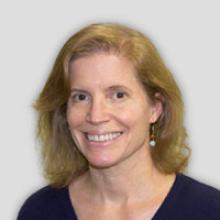Moody Faculty Spotlight: Deb Lewis
Published Spring 2022
Deb Lewis is a cinematographer and associate professor of practice in the Department of Radio-Television-Film. She currently teaches Introduction to Light and Sound for both undergraduates and MFA students, as well as a Cinema Laboratory course.
Deb Lewis

I love my students, past and present. Moody College students tend to be curious, resilient, creative and wonderfully independent thinkers. I emphasize respect in my classes, and I find that most Moody students treat one another, the faculty, staff, and their film crews as they’d like to be treated themselves.
I love the intersections between departments. That’s been one of the many sad aspects of the pandemic - the lack of in-person elevator rides where we can converse, share, and enlighten one another.
How does your professional background/experience inform your teaching practices?
In academia, it’s called experiential learning, which is a fancy term for learning through doing. My experience on feature film sets in New York City, working with a wide variety of filmmakers and crews informs what can and can’t be taught in a classroom. So that’s my main takeaway from “real world” experience–when space and guidance is provided for students to make movies, either their own or through helping out on other people’s films, students gain both confidence and a cinematic voice. Assignments and exercises are designed to replicate real world processes as much as possible.
Another thing my professional experience taught me is the importance of taking classes outside of production courses – art history, film history, world history, film studies, literature, photography. It will make you a much better filmmaker. In pre-production for a film, the key creative teams are talking about painters they love, their favorite music, great books. Rarely do they talk tech.
I know from shooting narrative and documentary features that rushing rarely pays off. Students want slightly different things out of their classes, and you can’t please all the people all the time. However, if you teach from a place of genuine enthusiasm, students engage in the material and the assignments.
What do you think about when you are designing/prepping a new course?
That’s a tough question right now because of hybrid instruction. Because all my classes require students to use equipment, and not knowing when students will get their hands on said equipment (in order to do the creative work), I need to be agile in designing my courses so we can be flexible in the face of a shifting pandemic landscape.
I think about pacing out units so that students stay engaged and have just enough time to get their assignments done and move on to the next. I create a spine to the course so the progression makes sense in an additive way. In general, I prefer to start semesters with a bang, i.e., hands-on work starting day one. That’ll happen again when we’re back in person.
What would you say is a common misconception about teaching large classes? About teaching introductory classes?
A common misconception? I suppose it would be the idea that large classes are inherently impersonal, that students can sink into the woodwork and we wouldn’t notice, that students are talked at as opposed to being part of a conversation where their point of view and personal taste plays a huge part in the class becoming living, breathing community of young filmmaking cohort each semester.
I’ve been teaching RTF 318: Intro to Image and Sound for many years now, and students are surprised to hear that I get nervous before speaking in front of our 160 students. It’s the good kind of nervous, though. These are the same performative nerves I have before the first day of a film shoot. I share with my students my own strategies for balancing life and filmmaking work, and share my opinion that there’s no way around feeling nervous, but that it’s part of the process for many of us. The payoff is tremendous, and we’re lucky to make money making movies. Being able to guide students and make movies, well, that’s spectacular!
What was a highlight of last semester for you?
The highlight of last semester in RTF 318 was the day I looked at the weather in the morning and it described a perfect, warm-not-hot, fall day. I came to the lead TA Sinead Keirans and ULA Ana Lorant with an idea: Let’s have students make a 48-minute film during our 2-3:15 class meeting time. We mobilized, sent out announcements to students and they produced around 50 one-minute films before the end of class, uploaded with links to a shared spreadsheet. Last semester our bi-weekly classes met via Zoom until the end of semester screenings and the labs met in person. This was the first chance many of the students had to meet people outside their lab section. Students emailed me photos from their shoots, and it was truly a glorious day to lead this intrepid and creative cohort. Considering the speed at which they were working, each finished film was like a little miracle. I won’t lie. It’s been a hard few years for all of us, but days like these where the pure creative energy of a large cohort comes together in a shared quest, well that’s a blast.
I also need to mention another highlight of every semester: the craft talk visits. Students love meeting future instructors, present tech staff, and outside visitors like those at our “Life After Film School” roundtable.

